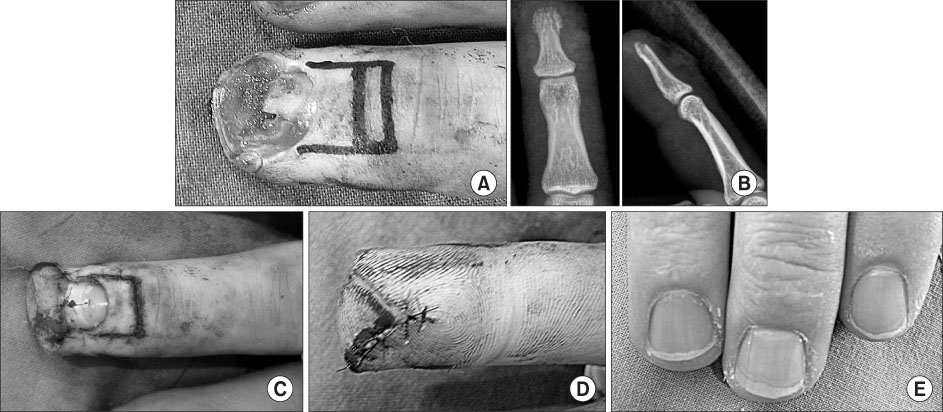J Korean Orthop Assoc.
2009 Aug;44(4):449-454.
Nail Lengthening using the Eponychial Flap
- Affiliations
-
- 1Department of Orthopedic Surgery, Yeson Hospital, Bucheon, Korea.
- 2Department of Orthopedic Surgery, Seoul National University College of Medicine, Seoul, Korea. minbom@gmail.com
Abstract
- PURPOSE
We wanted to introduce a nail lengthening technique with an eponychial flap for treating finger tip amputation, and we review the relevant literature. MATERIALS AND METHODS: Twenty-five patients who received eponychial flap surgery between November 2001 and April 2006 were enrolled in this study. Retrospectively, the patients were asked, by using a questionnaire, about their satisfaction with their nail shape and length. The preoperative findings and the findings at the last follow up and the contralateral finger nail lengths were measured with a ruler and those were all compared according to the percentage of change. RESULTS: The average operation time was fourteen minutes (range: 10 to 19 minutes). All the flaps survived and there was no infection, congestion of the flap, or additional deformity of nail. The average follow up period was five months. The nails were lengthened an average of 0.35 cm. The last follow up questionnaire showed that the patients were satisfied with their nail's appearance with an average score of 95.5 points. CONCLUSION: Nail lengthening using an eponychial flap is a convenient, safe and aestheticall pleasing procedure.
Keyword
MeSH Terms
Figure
Reference
-
1. Adani R, Marcoccio I, Tarallo L. Nail lengthening and fingertip amputations. Plast Reconstr Surg. 2003. 112:1287–1294.
Article2. Zook EG, Guy RJ, Russell RC. A study of nail bed injuries: causes, treatment, and prognosis. J Hand Surg Am. 1984. 9:247–252.
Article3. Martin C, González del Pino J. Controversies in the treatment of fingertip amputations. Conservative versus surgical reconstruction. Clin Orthop Relat Res. 1998. 63–73.4. Hosnuter M, Kargi E, Isikdemr A. An improvement in dorsal reverse adipofascial flap for fingertip reconstruction: nail matrix preservation. Ann Plast Surg. 2005. 55:155–159.5. Reardon CM, McArthur PA, Survana SK, Brotherston TM. The surface anatomy of the germinal matrix of the nail bed in the finger. J Hand Surg Br. 1999. 24:531–533.
Article6. Brown RE, Zook EG, Russell RC. Fingertip reconstruction with flaps and nail bed grafts. J Hand Surg Am. 1999. 24:345–351.
Article7. Tamai S. Twenty years' experience of limb replantation-review of 293 upper extremity replants. J Hand Surg Am. 1982. 7:549–556.
Article8. Muneuchi G, Kurokawa M, Igawa K, Hamamoto Y, Igawa HH. Nonmicrosurgical replantation using a subcutaneous pocket for salvage of the amputated fingertip. J Hand Surg Am. 2005. 30:562–565.
Article9. Oh SK, Lee YJ, Woo SH. Immediate Full-Thickness Nail Bed Graft with Various Skin Flaps for the Acute Nail Bed Defects of Fingertip Injuries. J Korean Soc Surg Hand. 2007. 12:151–157.10. Dumontier C, Tilquin B, Lenoble E, Foucher G. Reconstruction of distal loss of substance in the nail-bed by a de-epithelialized flap from the digital pulp. Ann Chir Plast Esthet. 1992. 37:553–559.11. Saito H, Suzuki Y, Fujino K, Tajima T. Free nail bed graft for treatment of nail bed injuries of the hand. J Hand Surg Am. 1983. 8:171–178.
Article12. Hsieh SC, Chen SL, Chen TM, Cheng TY, Wang HJ. Thin split-thickness toenail bed grafts for avulsed nail bed defects. Ann Plast Surg. 2004. 52:375–379.
Article13. Ogo K. Does the nail bed really regenerate? Plast Reconstr Surg. 1987. 80:445–447.
Article14. Endo T, Nakayama Y. Microtransfers for nail and fingertip replacement. Hand Clin. 2002. 18:615–622. discussion 23-4.
Article15. Patradul A, Ngarmukos C, Parkpian V, Kitidumrongsook P. Arterialized venous toenail flaps for treating nail loss in the fingers. J Hand Surg Br. 1999. 24:519–524.16. Kim JY, Kwon ST. Correction of contracted nail deformity by distraction lengthening. Ann Plast Surg. 2008. 61:153–156.
Article17. Dufourmentel C. Esthetic problems in the reconstruction of digital stumps. Ann Chir. 1971. 25:995–999.18. Foucher G, Lenoble E, Goffin D, Sammut D. Escalator flap in the treatment of claw nail. Ann Chir Plast Esthet. 1991. 36:51–53.19. Bakhach J, Demiri E, Guimberteau JC. Use of the eponychial flap to restore the length of a short nail: a review of 30 cases. Plast Reconstr Surg. 2005. 116:478–483.
Article20. Fleckman P, Allan C. Surgical anatomy of the nail unit. Dermatol Surg. 2001. 27:257–260.
Article21. Lucas GL. The pattern of venous drainage of the digits. J Hand Surg Am. 1984. 9:448–450.
Article22. Bakhach J. Eponychial flap. Ann Chir Plast Esthet. 1998. 43:259–263.
- Full Text Links
- Actions
-
Cited
- CITED
-
- Close
- Share
- Similar articles
-
- Restoration of the Injured Fingertip with Eponychial Cutaneous Flap
- Immediate Nail Lengthening with the Eponychial Folding Procedure in Acute Finger Tip Injury
- Reconstruction of Central-Type Nail Bed Defect Using a Subcutaneous Flap and Subsequent Nailbed Graft
- A Biomechanical Advantage of the Lengthening with an External Fixator Over an Intramedullary Nail: An Experimental Study in Saw Bones and Cadeveric Bones
- Columellar Lengthening Using V-Y Advancement Flap or Central Lip Flap in Secondary Correction of Bilateral Cleft Lip Nose Deformity



